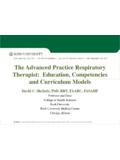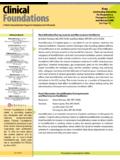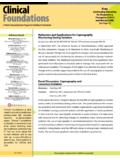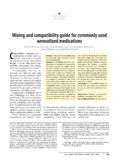Transcription of Postoperative care
1 Postoperative care Post operative note and orders The patient should be discharged to the ward with comprehensive orders for the following: Vital signs Pain control Rate and type of intravenous fluid Urine and gastrointestinal fluid output Other medications Laboratory investigations The patient s progress should be monitored and should include at least: A comment on medical and nursing observations A specific comment on the wound or operation site Any complications Any changes made in treatment Aftercare: Prevention of complications Encourage early mobilization: o Deep breathing and coughing o Active daily exercise o Joint range of motion o Muscular strengthening o Make walking aids such as canes, crutches and walkers available and provide instructions for their use Ensure adequate nutrition Prevent skin breakdown and pressure sores: o Turn the patient frequently o Keep urine and faeces off skin Provide adequate pain control Discharge note On discharging the patient from the ward, record in the notes: Diagnosis on admission and discharge Summary of course in hospital Instructions about further management, including drugs prescribed.
2 Ensure that a copy of this information is given to the patient, together with details of any follow-up appointment WHO/EHT/CPR: WHO Surgical Care at the District Hospital 2003 Postoperative Management If the patient is restless, something is wrong. Look out for the following in recovery: Airway obstruction Hypoxia Haemorrhage: internal or external Hypotension and/or hypertension Postoperative pain Shivering, hypothermia Vomiting, aspiration Falling on the floor Residual narcosis The recovering patient is fit for the ward when: Awake, opens eyes Extubated Blood pressure and pulse are satisfactory Can lift head on command Not hypoxic Breathing quietly and comfortably Appropriate analgesia has been prescribed and is safely established WHO/EHT/CPR.
3 WHO Surgical Care at the District Hospital 2003 Post operative pain relief Pain is often the patient s presenting symptom. It can provide useful clinical information and it is your responsibility to use this information to help the patient and alleviate suffering. Manage pain wherever you see patients (emergency, operating room and on the ward) and anticipate their needs for pain management after surgery and discharge. Do not unnecessarily delay the treatment of pain; for example, do not transport a patient without analgesia simply so that the next practitioner can appreciate how much pain the person is experiencing. Pain management is our job. Pain Management and Techniques Effective analgesia is an essential part of Postoperative management.
4 Important injectable drugs for pain are the opiate analgesics. Nonsteroidal anti-inflammatory drugs (NSAIDs), such as diclofenac (1 mg/kg) and ibuprofen can also be given orally and rectally, as can paracetamol (15 mg/kg). There are three situations where an opiate might be given: o Preoperatively o Intraoperatively o Postoperatively Opiate premedication is rarely indicated, although an injured patient in pain may have been given an opiate before coming to the operating room. Opiates given pre- or intraoperatively have important effects in the Postoperative period since there may be delayed recovery and respiratory depression, even necessitating mechanical ventilation. Short acting opiate fentanyl is used intra-operatively to avoid this prolonged effect.
5 Naloxone antagonizes (reverses) all opiates, but its effect quickly wears off. Commonly available inexpensive opiates are pethidine and morphine. Morphine has about ten times the potency and a longer duration of action than pethidine. (continued next page) WHO/EHT/CPR: WHO Surgical Care at the District Hospital 2003 Post operative pain relief (continued) Ideal way to give analgesia postoperatively is to: o Give a small intravenous bolus of about a quarter or a third of the maximum dose ( 25 mg pethidine or mg morphine for an average adult) o Wait for 5 10 minutes to observe the effect: the desired effect is analgesia, but retained consciousness o Estimate the correct total dose ( 75 mg pethidine or mg morphine) and give the balance intramuscularly.
6 O With this method, the patient receives analgesia quickly and the correct dose is given If opiate analgesia is needed on the ward, it is most usual to give an intramuscular regimen: Morphine: Age 1 year to adult: mg/kg Age 3 months to 1 year: mg/kg Pethidine: give 7 10 times the above doses if using pethidine Opiate analgesics should be given cautiously if the age is less than 1 year. They are not recommended for babies aged less than 3 months unless very close monitoring in a neonatal intensive care unit is available. Anaesthesia & Pain Control in Children Ketamine anaesthesia is widely used for children in rural centres (see pages 14 14 to 14 21), but is also good for pain control. Children suffer from pain as much as adults, but may show it in different ways.
7 Make surgical procedures as painless as possible: o Oral paracetamol can be given several hours prior to operation o Local anaesthetics (bupivacaine , not to exceed 1 ml/kg) administered in the operating room can decrease incisional pain o Paracetamol (10 15 mg/kg every 4 6 hours) administered by mouth or rectally is a safe and effective method for controlling Postoperative pain o For more severe pain, use intravenous narcotics (morphine sulfate mg/kg IV) every 2 4 hours o Ibuprofen 10 mg/kg can be administered by mouth every 6 8 hours o Codeine suspension 1 mg/kg can be administered by mouth every 6 hours, as needed. WHO/EHT/CPR: WHO Surgical Care at the District Hospital 2003

















